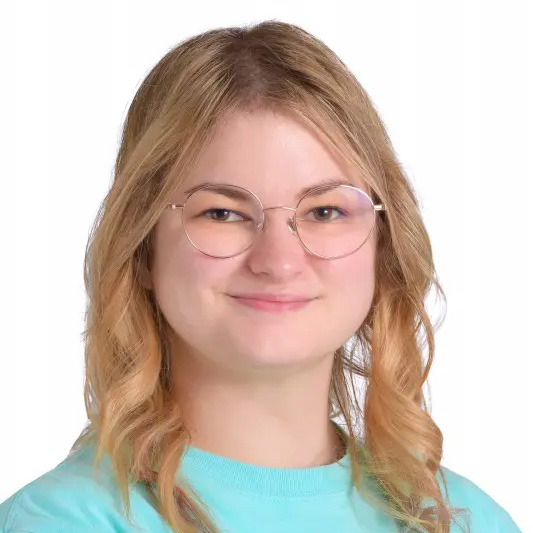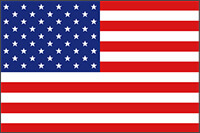[Summative Assessment] IB PYP UOI Class Introduction (3-year-old)
What does International Baccalaureate mean for 3-Year-Olds?
Since April 2023, CGK International School has implemented the International Baccalaureate Programme (IB Curriculum), including Jungle B Class (three-year-olds). The IB Programme focuses on student-led inquiry, allowing the students to guide what is taught and learned within and outside our classroom walls. In Jungle B Class, we had four Units of Inquiry (UOI’s) that the students could use to explore and expand their world: Who We Are, How We Express Ourselves, How the World Works, and How We Organize Ourselves. We held How We Express Ourselves throughout the duration of the academic year.
Why is Play and Art Important for Self Expression?
We know that the best way young children express themselves is through play and art. It is also how children show what they have learned and what they already know. Through this UOI, we can see transdisciplinary interactions between other Units of Inquiry. For Who We Are, students can share their family types through drawing. With How the World Works, they can create different ecosystems using animal and plant toys. For How We Organize Ourselves they can pretend to be farmers and sales clerks to imitate how Farmers and Supermarkets provide food for the community.
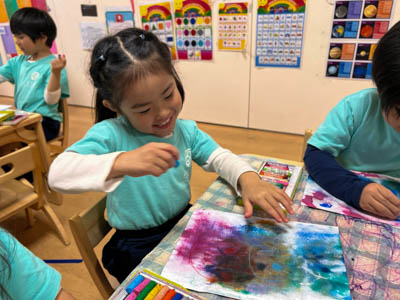
What is a Summative Assessment?
With the IB Curriculum, we have a Summative Assessment to gauge how each student has absorbed information and watch them apply it. Recently, Jungle B had their Summative Assessment for How We Express Ourselves: Exploring Art and Play.
As we get older, to encourage critical thinking and empathy, it’s crucial to experience cooperating and collaborating effectively within a team. In Jungle B, we did this by requiring students to work together in groups of two, three, or four students to create an Art Gallery. We decided not to let them work individually and not in groups of five or more to keep conflicts at a minimum. We also required students to decide their groups. How can that be applied to three and four-year-olds? First, we need to set some ground rules.
- Once at your station, do not change where you go.
We wanted to ensure that each student stayed within their groups to help create order within the classroom and to challenge the students to think, “What can I do here? How can I add to this?” if they get bored. - Before you add something, ask your partners if it’s okay.
This is how we promoted student-led agency within the Summative Assessment. Students had the right to say “I don’t like that idea” and were given the opportunity to negotiate what they wanted. They could come up with a new idea, think of an idea that is halfway, or decide not to do their original idea at all. As teachers, we only facilitated in a way that progressed conversations positively, not just for convenience or our own ideas. Lately, we have also been encouraging students to use nice words. It’s easy to say “Stop that! No!” and get angry when collaborating. To learn how to manage emotions, we have been asking them to use nicer words that lead to peaceful negotiations. - When the timer is finished, do not clean up
After everyone had finished, we wanted everyone to walk around and explore their Jungle B Art Gallery to give feedback and see what everyone had created. This creates an environment where all students can positively reflect on their own and other’s work. - Don’t pick something just because your close friends are doing it; select something you want to create.
Sometimes, we notice that students “pressure” others to play with them. Some students struggle to say no in order to keep friends happy instead of doing something within their own desires. We pushed this so friends who wanted to color instead of play with toys would feel free to color with crayons. This was another strategy we used to promote student agency within our classroom.
Once all of the ground rules were set and everyone agreed to them, we let the students choose between four mediums for their gallery piece: clay, Crayons, cut-and-paste, and Toys. We ended up with five groups: two groups of clay (one with two students, the other with three), one group for crayons (with four students), one group with toys (three students), and one group of cut-and-paste (with three students).
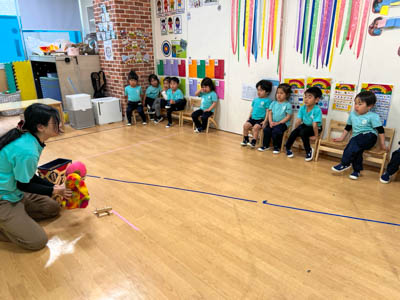
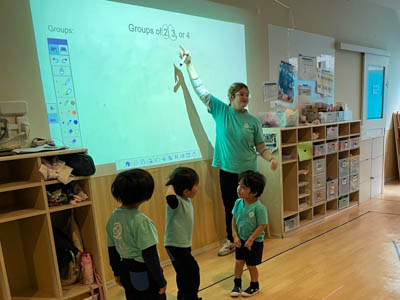
To truly test if they could cooperate with each other without fighting, their first objective was to come up with a group name. Most of the students went with more basic names, while some had more fun names. We ended up with:
- Cut-Cut! (Cut and Paste)
- Clay Friends (Clay)
- Crayon Friends (Crayon)
- Play Friends (Toys)
- Robot Friends (Clay #2)
They did this easily with no fighting! So, we moved on to the next portion of the Summative Assessment: implementation. Each group had 40 minutes to create their gallery piece.
Cut-Cut! (Cut and Paste)
This group used pieces of construction paper, their scissors, and glue to create anything they wanted onto a large piece of white paper. At first, they put pieces of paper in a way that looked like a 3D V.
Student One: Ah! It’s like a tent.
Student Two: Yeah, it does look like a tent!
Teacher: What else can you add to the tent?
Student Three: A camp! We can make a camp!
With the teacher only asking questions that promote inquiry, the Cut-Cut team had their theme almost instantly and worked well the rest of the time to create a campsite out of construction paper.
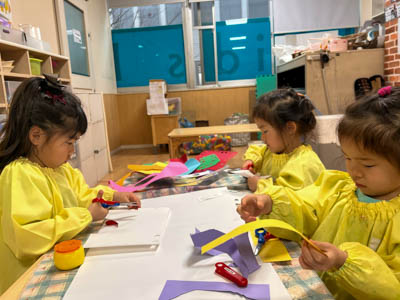
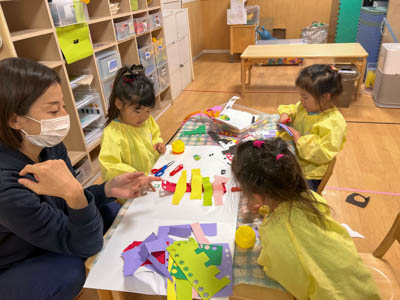
Clay Friends (Clay)
This group only had two students, so it was easy to work well together.
Student One: I’m making donuts!
Student Two: I’m making cookies! So Yummy. Here, Ms. Emily, try it!
Me(Emily): Oh, that is so yummy! What food are you making for the gallery? Is it a restaurant?
Student One and Two: No!
Me(Emily): Picnic?
Student One and Two: Yes! A picnic! Let’s make a picnic!
Clay friends, able to cooperate well, also had a theme picked out quickly and were able to make snacks for their Picnic Theme.
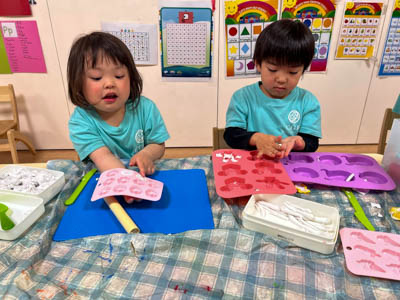
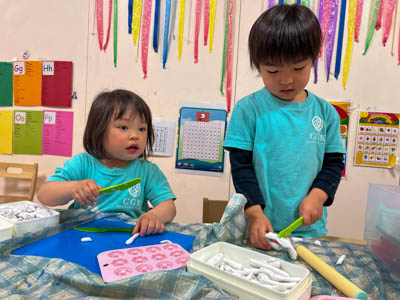
Crayon Friends (Crayon)
This group, with four students, struggled a bit more at first. Since there were four pieces of A3 paper taped together, they thought they could only draw on their own paper and really didn’t think of a specific theme for their art gallery. Once I told them they could draw on the other papers and that they didn’t have to sit down, they were drawing all over the papers. However, they did have to negotiate a bit more.
Student One and Two: Can we color here?
Student Three: No, I don’t want you to.
Student Four: But it’s everyone’s paper…
Student Three: Can you draw in this spot instead?
Student Two: Okay!
This style of conversation and negotiation helped everyone think critically to ensure no fighting while still creating an amazing piece of art. Each student could show their personalities through the art while still displaying their interconnectedness as Jungle friends.
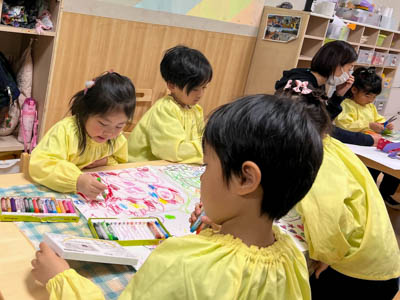
Play Friends (Toys)
At first, this team only started with Kaplas, but they decided to add animal toys. Their theme came naturally and easily: building a forest with a Kapla tower! Even after the tower fell, they laughed and said that the animals had to get tickets to enter the forest and wait their turn—creating an entire story! They were able to talk smoothly, negotiate easily, and have fun while creating their gallery.
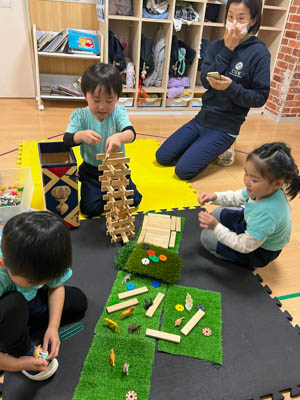
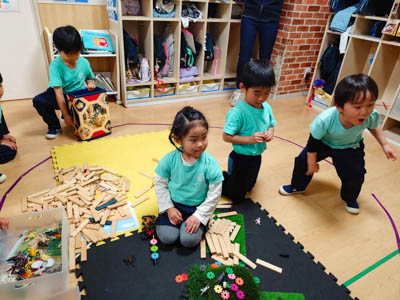
Robot Friends (Clay Team 2)
This group, with three students, struggled a bit more to develop their theme. At first, everyone was creating different subjects and argued about it a bit.
Student One: I want to make Doraemon!
Student Two: I want Spiderman!
Student Three: But I want to make Numberblocks… I don’t like Doraemon.
Me(Emily): I hear you want to make different characters. What theme can we do with that?
Student Two: I don’t know… They’re all different.
Me(Emily): What about characters? Or something else completely?
Student One: Characters!
Eventually, as Three/Four-Year-Olds do, they got bored making characters with clay and wanted to do something else. To help freshen their medium, I added some insect toys from the Play Friends group. All their faces lit up and they mixed the two.
Student Two: I’m going to make Spider Sandwiches!
Student One: Yucky! I’m going to make Cockroach Cookies!
Student Three: Spider Ice Cream! Hahaha!
And there was their theme: Insect Food! They were able to make it with ease after going through multiple ideas.
Then… Time was up! 40 minutes passed and each student returned to their seats.
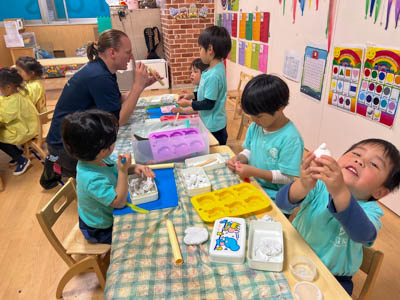

Reviewing Everyone’s Gallery Piece
Next, we walked around the classroom as a group to look at what each group created. They gave feedback, talked about what they liked, what they thought was funny, and each group felt pride showing off what they created to their classmates.
At the end of the Summative Assessment, we talked about different ways we can express ourselves through art and play, and the different toys, games, and crafts we made throughout the year. We talked about what toys we did like and what we didn’t like, and remembered the school year as Jungle Friends fondly.
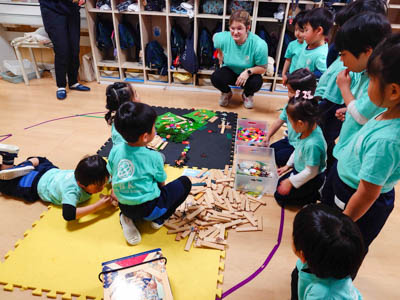
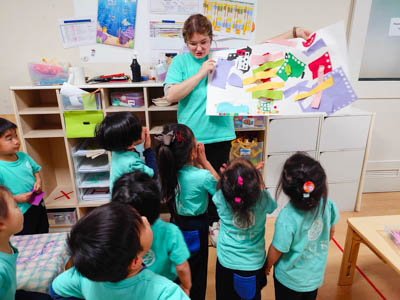
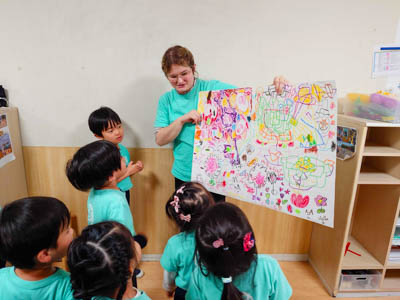
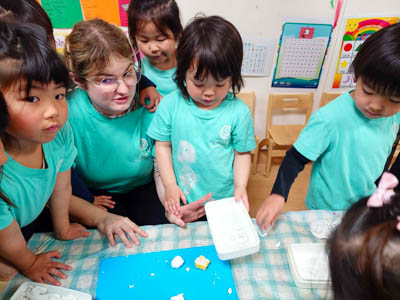
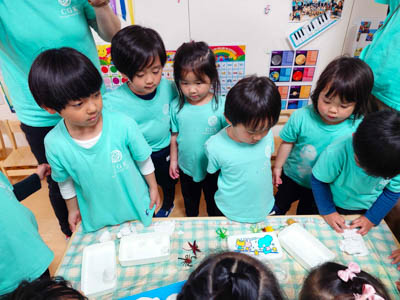
Author Profile
-

-
Emily - Preschool Teacher (USA)

Preschool teacher for 5-year-old class at CGK International School.
Major in Global & International Studies and Japanese Language & Culture.



